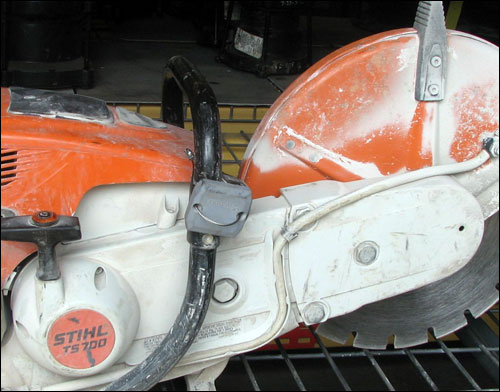The purchasing division of Florida’s Seminole County is employing an RFID tracking system to manage its 10,000 tangible assets, with expectations that it will ultimately reduce the cost of managing inventory across its 130 countywide locations by 34 percent. The solution, provided by systems integrator Silent Partner Technologies, reduces the amount of labor required by the procurement department, as well as by the managers of other county departments that utilize those same assets.
Seminole County, located in the central part of the state, comprises seven cities and owns $90 million worth of assets, including electronic office equipment; tools used by the public-works department for road work, traffic engineering or mosquito control; and high-value firefighting gear utilized by the public-safety department. The purchasing division manages all pieces of equipment valued at $1,000 or more, and conducts a physical inventory of all items once annually, says Betsy Cohen, a county procurement supervisor. To accomplish this task, the division has traditionally used Oracle‘s JD Edwards software system and Microsoft Excel spreadsheets to record what is on hand at each office or facility. Every year, the county sent a list of items that should be located at each facility or department, and supervisors or department heads were responsible for verifying which assets were indeed at those locations, as well as noting which were not. The procurement office would then follow up with investigating the whereabouts of any missing items.

Until recently, the procurement division had a staff member assigned to oversee the county’s inventory counts. Due to budget cuts, this position was eliminated, though it was later reestablished—but with greater responsibilities, leaving less time for inventory management.
“We needed to find a more-efficient way to get the inventory done,” Cohen explains. Approximately two years ago, the department began looking into an RFID solution. Her office acquired six CSL 101-2 handheld RFID readers from Convergence Systems Ltd., but found the JD Edwards system could not support data from RFID readers, and thus began searching for a full RFID solution. The procurement division contacted Silent Partner in 2010, and commenced the process of attaching EPC Gen 2 tags to all 10,000 of its assets at the end of that year and into early 2011, according to Ted Kostis, Silent Partner’s president.
The result is a system that allows spot-inventory checks to be carried out at any time of the year, with the procurement division sending personnel to offices or facilities in order to verify the locations of some pieces of equipment. During these spot-checks, they employ a CSL 101-2 handheld reader and captured the ID numbers of items at these locations.
The county will put the system fully to the test this fall, when it conducts its annual inventory of all of its departments. Instead of e-mailing a spreadsheet containing a list of assets to each department, the procurement division’s staff members will make visits using a CSL 101-2 handheld reader. First, they will utilize the handheld device to download data stored in the Silent Partner software on the county’s back-end system. The standalone RFID software stores and manages all data regarding inventory for each department, and interprets and displays information from RFID read events. The data on the reader lists all assets that should be located in the departments being visited.The employees will then walk through each facility or office, place the interrogator next to each asset and capture the unique ID encoded to that item’s RFID tag, so that the software can determine whether the asset corresponds with one found on the inventory list. Once the visits are completed, the staff will return the readers to the procurement office, where the details will be uploaded to the Silent Partner software on the PC.
Those discrepancies, Cohen says—such as an item that is missing or is in the wrong location—will be noted, though the procurement division will not conduct any investigations until the entire inventory process is finished. At that time, the software will indicate if any lost items turn up in other departments (such as a missing asset from the public-works department that might be located in the environmental-services department, which pumps, treats and delivers drinking water and processes sewage). The procurement staff will then be able to determine whether to accept each item’s new location or have it moved.
The system has already paid for itself, Cohen says, by locating several underused assets during spot-checks. Those items that were not being utilized—because they were, perhaps, located in the wrong department—could either be put to work in another location, or sold. Once the full annual inventory is completed in the fall, Cohen says she will then have statistics regarding the increased efficiency provided by the RFID system. She projects that the solution will decrease the cost of operating the procurement office by 34 percent, through a reduction in labor, and also forecasts that many department inventories could be conducted in a matter of minutes, while others—such as the public works—will take longer since those departments’ assets are located at a variety of sites throughout Seminole County.
Recently, the public-safety department began using the system as well, in order to track its own assets, including firefighting equipment and other emergency-response tools. Although all items valued at more than $1,000 had already been tagged by the procurement division, public-safety workers have tagged the remainder of their department’s approximately 6,000 mobile assets that go out on fire or other safety vehicles, to help manage the inventory at its central warehouse. That department used the same models of tags provided by Silent Partner for the procurement office.
Within two months, the public safety department also plans to use the system to track pharmaceuticals stored on emergency medical services (EMS) vehicles. EPC Gen 2 passive RFID tags will be applied to medications sent on emergency calls, and members of the public-safety staff will then use a handheld reader at each vehicle to conduct spot inventories, thereby ensuring that the necessary drugs are on hand at all times.
Tagging the equipment proved challenging, Cohen says, due to the variety of form factors used. For example, the county has a large quantity of equipment that may be utilized underwater, such as water-testing tools, on which the procurement workers have applied RFID tags provided by Confidex. Other assets, such as generators, remain outdoors and are thus exposed to the elements, while some are quite small, such as radios. For that reason, Silent Partner provided a variety of RFID tags in a range of sizes, some ruggedized for outdoor weather, to suit the equipment to which they are applied.
In fact, Kostis says, identifying the best tag for each item was the greatest challenge the system faced. Silent Partner worked with Seminole County to ensure that the tags could be affixed to each asset and not be damaged or lost; much of that process, he notes, involved trial and error, applying specific tags and monitoring how they performed. This required working with several RFID tag vendors that custom-developed about 10 different tag form factors for the county’s equipment.


